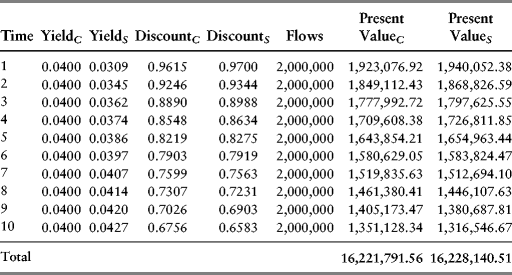Discounting Using Spot Rates
There are plenty of excellent treatments of the term structure. I therefore keep this chapter short and to the point. The yield curve is a plot of Treasury spot rates. The spot rate is the current market interest rate for a given term (for example, the yield on the one-year Treasury bill). For example, lending $1 at 10 percent for a single year means that the one-year spot rate is 0.10. If you were to lend the $1 for a period of two years at 10 percent annually, then the two-year spot rate is also 0.10. So, for the one-year spot, s1, and a $1 investment, the factor by which that investment will grow is ![]() . For the same $1, over two years, that investment will grow to
. For the same $1, over two years, that investment will grow to ![]() , or 100∗s2 percent in each of two years. In general, then, $1 will grow at
, or 100∗s2 percent in each of two years. In general, then, $1 will grow at ![]() for a period of t years at an annual rate equal to st. If the rate is compounded m times per year, then this changes to:
for a period of t years at an annual rate equal to st. If the rate is compounded m times per year, then this changes to: ![]() . And, if the rate is compounded continuously, then as we have shown before,
. And, if the rate is compounded continuously, then as we have shown before, ![]() , where the second time term (t) denotes the span of years. Discounting is just the inverse operation. For example, a cash flow of $1 that is to be realized in t years has value
, where the second time term (t) denotes the span of years. Discounting is just the inverse operation. For example, a cash flow of $1 that is to be realized in t years has value ![]() at the present time. If interest is compounded m times per year, then the discount factor d(t) becomes
at the present time. If interest is compounded m times per year, then the discount factor d(t) becomes ![]() , and if continuously compounded,
, and if continuously compounded, ![]() . Moreover, if we knew the term structure of spot rates, then a cash flow stream through time of
. Moreover, if we knew the term structure of spot rates, then a cash flow stream through time of ![]() to be received in periods
to be received in periods ![]() has present value
has present value ![]() , where the di are the aforementioned discount factors. Notice that this formulation is different from that for valuing bond-paying coupons
, where the di are the aforementioned discount factors. Notice that this formulation is different from that for valuing bond-paying coupons ![]() . The difference is that in the bond valuation case, we determined the internal rate of return (the yield to maturity), which was a single discount factor; it was a geometric mean (see Chapter 1). In reality, if one knew the spot rates for differing time periods, then one could discount a stream of cash flows using the proper discount factors and not a single factor like the yield to maturity. Keep in mind, however, that the purpose of calculating yield to maturity on a bond was to find a unique rate of return that equated the present value of a cash flow stream to its market price.
. The difference is that in the bond valuation case, we determined the internal rate of return (the yield to maturity), which was a single discount factor; it was a geometric mean (see Chapter 1). In reality, if one knew the spot rates for differing time periods, then one could discount a stream of cash flows using the proper discount factors and not a single factor like the yield to maturity. Keep in mind, however, that the purpose of calculating yield to maturity on a bond was to find a unique rate of return that equated the present value of a cash flow stream to its market price.
Table 3.1 Fixed versus Floating Discount Factors

